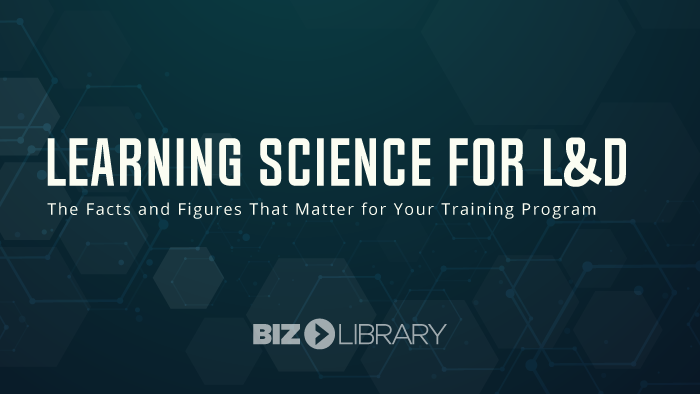As cliché as it sounds, we learn something new every day. At BizLibrary it is one of our core values to be “Smarter Every Day.”
As learning and development professionals you’ve surely already studied how adults learn, but you may be struggling to ensure the principles of adult learning theory are applied to your training through effective techniques.
This article will guide you to make practical changes to your organization’s training program based on adult learning theory.
What Is Adult Learning Theory?
Adult learning (andragogy) is the practice of educating adults to develop their knowledge or skills. Adult learning theory contains five key assumptions about adult learners, and using the ideas put forth in this theory can help organizational L&D professionals create more meaningful learning experiences for employees.
Principles of Adult Learning Theory and Their Application
Malcolm Knowles, the father of adult learning theory, makes the following assumptions of how adults prefer to learn. By understanding these principles of adult learning, you can design a workplace training program that enhances the learning experience and maximizes its effectiveness.
1. Adults and Self-Concept
As a person grows older, they shift from being more dependent to independent. Therefore, the way they want to learn shifts from being instructor-led to more self-directed. Adults need to be involved in the planning and evaluation of their training to fully engage with it.
Application:
Allow the individuals in your organization control over the subject matter they will be learning and how and when they access it. Use off-the-shelf content within a flexible platform, like an an LMS, to allow for exploratory learning whenever an employee can schedule time in their day.
BizLibrary features robust searching and filtering capabilities which help quickly narrow down the topic an employee is searching for to find the right video for every situation. The BizLibrary Recommendation Engine suggests content based on a learner’s assignment, recent learning activity, and profile preferences, just like your favorite TV or movie streaming services.
Another great way to incorporate the self-concept assumption is by offering a soft skills assessment to your learners. During this assessment, employees will find out which of their soft skills could use the most improvement, which allows them to be a part of the planning of their training initiative.
Take our soft skills assessment to see which soft skills you can improve, and then take it to your teams to identify their soft skill gaps.
2. Experience of Adult Learners
As a person matures, they accumulate a growing reservoir of experiences that become an increasing resource for learning. Adults gain more from training when they can pull from past experiences and validate what they’re learning based off what they already know – this adds greater context to their learning. Experience (including mistakes) provides the basis for learning activities.
Application:
Instruction should be task-oriented instead of promoting memorization– learning activities should be in the context of common tasks to be performed by employees. They need to solve problems and use reasoning to take in new information.
At BizLibrary, before we write even one word of a new lesson, we need to know what employees DO on the job to get needed results, including knowledge and skills that allow them to perform as needed. Conducting a skills gap analysis can assist L&D professionals in determining the experience level of the employee and what kind of training they need. To produce the desired results, look for the following information:
- How [job title] performance impacts desired business results.
- What [job title] needs to do to impact desired business results.
- What knowledge and skills does [job title] need in order to perform these tasks?
- Does [employee or candidate] already possess any of the skills or knowledge needed for [job title]?
Conducting a skills gap analysis can help you to better personalize each employee’s training based on their prior experience. BizLibrary helps to address this through curated learning paths separated into beginner, intermediate, and advanced skill levels for topics such as communication, leadership and management, customer service, and performance management.
3. Adults’ Readiness to Learn
Adults become ready to learn as things arise that they need to know in the moment. Adults want to learn what they can apply right away, which makes training less effective when it’s focused on the future or unrelatable to current situations. Adults are most interested in learning subjects that have immediate relevance and impact to their job or personal life.
Application:
Create personalized learning and development plans. It’s not always reasonable and often ineffective to make all employees follow the same learning path. These should be based upon what is most relevant to the individual or group of employees in a similar role for them to be successful. Using an online learning platform, you or your managers can create playlists that are customized to each employee’s needs.
Beyond assigned or recommended training, a curated content library like The BizLibrary Collection will allow employees to find training videos on specific subjects in the moment of need.
Most microlearning lessons take 10 minutes or less, so training is available at the tips of the learners’ fingers, whether they want to brush up on negotiation skills right before a big call with a potential customer, take a lesson on how to have difficult conversations with an employee, or anything in between. BizLibrary clients love the fact that our content is accessible from any type of device, at any time, for exactly these kinds of needs.
4. Adults’ Orientation to Learning
Adults’ perspectives change from procrastination to immediate application of learning as they grow. As a result, their orientation toward learning shifts from one of subject-centeredness to one of problem-centeredness.
Application:
Since adults prefer to self-direct their learning, training offerings should allow employees to discover and retain knowledge for themselves without depending on others. However, learners should be offered guidance and help when mistakes are made, or a solution to a problem requires others’ input and feedback.
With an online learning library containing advanced search and filtering options, learners can quickly find a lesson or course that will help them address the issue at hand. These off-the-shelf videos make it quick and easy for an employee to find the right topic, take in the information, and apply it to the problem they’re working to solve. With professionally curated video libraries, employees are able to learn in the moment and keep productivity high.
5. Motivation to Learn for Adults
Adults move from extrinsic towards intrinsic motivation as they grow and mature. Extrinsic motivation involves doing something because you want to earn a reward or avoid punishment, while intrinsic motivation involves doing something because it’s personally rewarding to you. Basically, they will learn if they want to learn. They want to be able to ask themselves, “What’s in it for me?” and have a satisfactory answer.
Application:
Motivating employees to high performance takes more than a nice paycheck and a “good job.” Each employees’ motivators are different and must be learned by their manager. Some tips on helping employees become intrinsically motivated to learn are:
Autonomy in learning: When employees have choices instead of being instructed to do something it gives them a sense of control and their intrinsic motivation increases.
Relatedness: Encourage social learning with group work to make employees feel connected. When employees feel a sense of belonging, they experience more meaningful relationships and improved performance.
Competence: Employees need to feel that they are equipped to meet challenges in the workplace. Managers can cultivate competence by giving tasks that may be challenging and then providing feedback and information on how to complete the task.
Use Science and Adult Learning Theory for a Stronger Training Program
Adult learners recall information best when it is relevant and useful. Therefore, it is imperative to know the reason for learning a specific skill. As they possess a mature mindset, adults are often better at creating solutions to real-life issues as opposed to simply memorizing information. Problem-solving, immediate application, and performance-based tasks are all part of the backbone of adult learning.
When it comes to corporate training and employee development, there’s a lot of information out there. Deciding what strategies are right for your organization can be tough, especially when you’re confronted with dozens of opinions from hundreds of sources.

